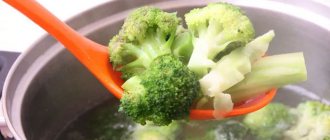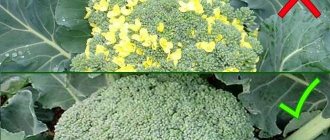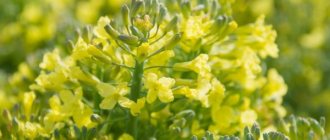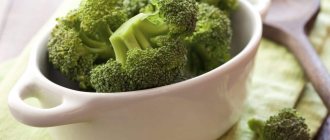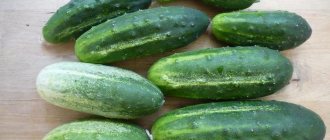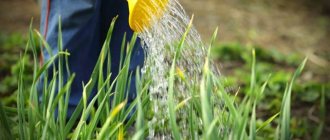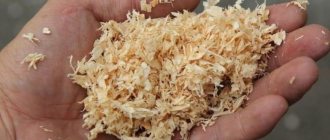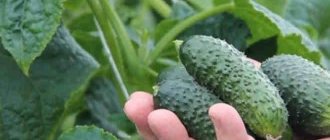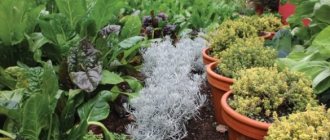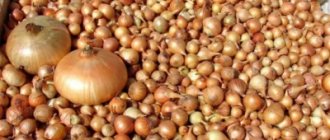Features of broccoli
In this rather unpretentious variety of cabbage, it is not the leaves that are edible, but the unopened inflorescences, which are natural multivitamins due to their composition.
Nutritional properties and unique composition
At the beginning of the 20th century, Russian scientists N.I. Kichunov and R.D. Schroeder gave broccoli the highest rating, placing it above cauliflower. It contains more protein than asparagus, spinach, sweet corn, sweet potatoes, essential amino acids - the same as in beef, and lysine, isoleucine and tryptophan - as in chicken eggs.
Broccoli inflorescences contain vitamins A, B1, B2, PP, C, E, K, potassium salts, magnesium, phosphorus, and calcium. This culture contains methionine and choline - anti-sclerotic substances that prevent the accumulation of cholesterol in the body and improve memory. Broccoli also contains the substance sulforaphane, which prevents the formation of cancer cells, and sinigrin, which destroys malignant cells. Therefore, this vegetable plant is a must-plant for a long and healthy life.
It is very healthy to eat broccoli raw, but it is also easy to cook.
Nuances of cultivation
Very often, having failed at the first planting, vegetable growers abandon this crop. However, growing this vegetable is not difficult, you just need to know some features.
Broccoli is light-loving and grows best in humus-rich, well-drained soil with a pH between 6.0 and 6.8. Broccoli is a crop of moderate temperature (+16–25 °C) and humidity (relative soil humidity 75%, air relative humidity 85%). The vegetable is hardy and can withstand temperature drops down to -7 ° C, late-ripening varieties are especially cold-resistant. But plants react to rising temperatures with rapid growth and, of course, you must not miss the moment and have time to cut off the head before flowering.
Broccoli heads must be cut off before flowering, otherwise they become inedible.
In the southern regions, broccoli should be grown only as an early spring crop and in the fall for winter storage. But in the middle zone and in the north, this culture feels great.
Diseases and pests
The main disease of broccoli is considered to be blackleg - a disease in which the root gradually rots. You can notice it by the fact that the broccoli foliage has changed color to a paler color and has become lethargic and stunted. When a root is pulled out of the soil, sunken, putrefactive, dark-colored destruction is visible.
It makes no sense to fight the problem, because it is determined at a later stage, when the fungal disease is already progressing at the highest level. Therefore, the main help against blackleg is considered to be preventive measures:
- disinfection of seeds and soil;
- loosening the soil and killing weeds;
- moderate watering;
- crop rotation;
- thinning plantings to ventilate the root part of broccoli.
The main insect pests of broccoli are slugs and caterpillars. To combat them, give preference to traditional methods:
- Infusion of potato or tomato tops. Fill 1/5 of a bucket of crushed plant material with 4/5 parts of water. Bring to a boil, boil for 3-5 minutes, and set aside in a warm place to infuse for a day.
- A solution based on tobacco dust, red hot pepper and laundry soap. Mix tbsp. l. pepper, a handful of tobacco, 40 g of soap and 10 liters of water. Let it brew for 2-4 hours. Strain and drizzle over broccoli. Do not forget that before eating such a composition, it is necessary to rinse thoroughly with running water.
- Crushed egg shells are good at repelling slugs.
Plant peppermint or marigolds next to the broccoli - caterpillars do not like the smell of their essential oils, which will protect the cabbage from attacks.
Among the chemicals, the drugs “Aktellik”, “Groza”, “Foxim”, etc. will help. Their use is possible subject to strict adherence to the rules and instructions.
More about cabbage diseases and pests is written in this article.
What to consider when choosing a variety, seed producers
Today, more than 200 varieties and hybrids of broccoli are known in the world. The State Register of Breeding Achievements includes 37 names of this wonderful vegetable. Seed producers are the Netherlands, France, Italy, Switzerland, Japan and, of course, Russia. They are approved for cultivation in all regions of the Russian Federation, so you should choose seeds for planting based on your needs and desires, taking into account the descriptions of the plants. The only thing that needs to be taken into account when choosing a variety to plant in your region is the ripening time. Broccoli of the latest ripening periods (130–145 days) should not be planted in Siberia and the Urals, where the short summer will not allow for a good harvest. It is also worth noting that the varieties have a brighter taste, and hybrids are superior to them in yield, resistance to frost, and unfavorable conditions.
The best varieties for the Middle Zone
The climatic conditions of the Middle Zone make it possible to grow cold-resistant varieties that can withstand changes in day and night temperatures. Early varieties of cabbage ripen beautifully in the middle zone. Planting seedlings helps speed up the process; then the first head of cabbage is cut off on the 38th day. Before the autumn cold snap, cabbage has time to ripen. The entire line of hybrids is also suitable, there are about 200 of them.
Broccoli reacts negatively to drought and cold weather and begins to bloom. Therefore, pay attention to color resistance when choosing.
The best varieties of broccoli with descriptions and characteristics
Like most vegetables, broccoli is divided according to its ripening period.
Early
Early ripening varieties of broccoli include varieties and hybrids of broccoli with a ripening period of up to 100 days. Typically, early-ripening varieties are not stored fresh for long, but they can be processed.
- Jung F1 is a super early hybrid, the originator of which is the breeding station named after N. N. Timofeev. Allows you to get a harvest 60–65 days after planting seedlings. The small green head is loose, weighs 200 g. Marketable yield is 1.3 kg/sq. m.
Video: Young's broccoli F1
- Green Magic F1 is an early maturing hybrid bred by the French company SAKATA, which has excellent taste, a larger head weighing up to 700 g, elliptical shape, gray-green color, medium density. Exhibits remontant properties and is resistant to diseases and pests. You can collect 2.2 kg per square meter.
Video: Broccoli Green Magic F1
- Chronos F1 is another early hybrid from SAKATA. Included in the State Register of the Russian Federation in 2021. The low plant forms dense blue-green inflorescences of medium to large size, weighing 0.5–0.6 kg, with excellent taste. The productivity of Chronos F1 is 2.7 kg/sq.m. m.
The hybrid Chronos F1 has a large, dense head weighing up to 600 g
- Tonus is a long-known, proven variety bred by the Federal Scientific Center for Vegetable Growing. The first central head weighing up to 200 g is formed at the end of July, then until October small heads are formed on the side shoots.
Photo gallery: long-term fruiting of the Tonus variety
- Vyarus is an early ripening variety, the originator of which is the AGRO-BEST company. Forms dense bluish-green heads with a diameter of 20 cm and a weight of 120 g. The plant is resistant to both low and high temperatures and produces a large number of secondary shoots. You can collect 2.9 kg per square meter.
The Vyarus variety of broccoli, resistant to both low and high temperatures, is grown in Russia, Moldova, and Ukraine.
- Venus F1 is an early ripening (80–90 days) hybrid that does not form side shoots, from the Sedek company. The heads are dense, dark green in color, weighing 350–600 g, and have excellent taste. Productivity 3.0–3.5 kg/m2. The hybrid is resistant to fusarium and the crop ripens smoothly.
Venus F1 is characterized by amicable maturation of the heads
Mid-early
Among the mid-early broccoli, the following hybrids can be distinguished:
- Fiesta of Dutch selection with very dense inflorescences weighing 300 g and excellent taste. The variety does not produce new shoots and is resistant to Fusarium wilt;
Fiesta F1 is resistant to fusarium
- Macho from a breeding plant, a low-growing plant with several stems, forms dense green inflorescences up to 300 g;
Hybrid Macho F1 is perfectly stored frozen - Naxos from the SAKATA company, the plant is tall, with one stem, has blue-green inflorescences weighing 600 g, excellent and good taste;
- A Moscow souvenir of Russian selection, of medium height, with a medium-density head weighing 400–450 g, gives a yield of 1.0–1.2 kg/sq.m.
Mid-early broccoli can be grown in Siberia and the Urals.
Mid-season
The ripening period for broccoli belonging to mid-season varieties is 105–130 days. The State Register of the Russian Federation includes the following varieties and hybrids of medium ripening:
- Batavia F1 of Dutch selection with a gray-green dense inflorescence of excellent taste, weighing 700 g, additionally forms secondary shoots and gives a yield of 2.6 kg/sq. m;
- Heraklion F1 from SAKATA is a tall hybrid, yield 2.5 kg per square meter, dense heads, weighing 550 g, excellent taste, there are secondary heads;
- Gnome - from the agricultural company Sedek has a medium-sized inflorescence weighing 400 g, gray-green color, medium density, there are secondary shoots with inflorescences. You can collect 2.4 kg per square meter. m;
- Curly head - another variety from Sedek, has smaller leaves and a larger head of 600 g;
- Curly is a variety from the breeding company Gavrish that does not form secondary inflorescences. Head weight: 600–700 g. The taste is excellent. Productivity - 2.6 kg per square meter. m;
- Linda is a medium-sized variety, with a dark green ellipse-shaped head, medium texture, weighing 300–400 g. Valued for its high yield (3–4 kg per sq. m); after cutting, the plant grows up to 7 side shoots with 50 heads each –70 g;
- Montop F1 is a hybrid from the Gardens of Russia company, it has a large medium-density head weighing 900 g, excellent taste, there are no secondary heads. Productivity - 3.1 kg/sq. m;
- Ronnie F1 is a tall hybrid of Italian selection, has gray-green dense heads weighing 500 g, does not form secondary shoots;
- Surfing F1 is an excellent hybrid from the Research Institute of Vegetable Growing on Protected Ground and the breeding company Gavrish. If there are secondary heads, the central one has a mass of up to 1.0 kg. The taste is excellent, the color is green, the density is medium. The hybrid yield is 3.7 kg per square meter. m;
- Stromboli F1 from Dutch breeders. The hybrid has inflorescences weighing 600–700 g, green in color, medium density, and excellent taste. You can collect 2.6 kg per square meter. m;
- Fortuna is a variety from the Poisk agricultural company near Moscow with a small (weighing 150 g) central head of delicate texture and excellent taste. Due to numerous shoots, it has a yield of 2.6 kg per square meter;
- Caesar is another variety in which, after cutting the central head, secondary ones grow. The weight of the central head is up to 135 g. The taste is good. It is possible to collect 2.5 kg/sq. m.
Photo gallery: mid-season broccoli varieties and hybrids
Late ripening
Late-ripening broccoli varieties are usually used for winter harvesting. In the northern regions there is a risk of not having time to get the harvest. Their ripening period is 130–145 days.
- Parthenon F1 is a hybrid from SAKATA with dense inflorescences of medium and large size, gray-green color, weighing 600–900 g, excellent taste. Productivity 3.3 kg/sq. m;
- Monrello F1 is a Swiss hybrid of excellent taste without the formation of secondary heads. Head weight - 700–800 g, yield - 3.6 kg/sq. m;
- Monopoly F1 is a productive (3.1 kg/sq. m) hybrid of Dutch selection that forms secondary inflorescences. Weight of the central head 600 g;
- Monaco F1 is another productive (4.2 kg/sq. m) Dutch hybrid with dense gray-green heads of medium size, weighing 600 g, and excellent taste. There are no secondary heads;
- Marathon F1 is a Japanese hybrid from SAKATA with a yield of 3.2 kg/sq. m, has a medium-sized green head, dense, with a delicate texture, weighing 800 g, excellent taste;
- Agassi F1 is a Dutch hybrid with a yield of 3.7 kg per square meter. m, with a medium-sized gray-green head, weighing 700 g, forms secondary heads;
- Lord F1 is a hybrid from Holland with a large head of light green buds, dense, weighing 0.8–1.2 kg, and excellent taste. Can collect 2.7 kg/sq. m.
Photo gallery: late-ripening broccoli hybrids
Mid-late
In the conditions of Siberia and the Urals, such hybrids can be grown in greenhouses.
- Ironman F1 is a Dutch variety with a gray-green inflorescence weighing 400–600 g and excellent taste. You can get a yield of 2.9 kg/sq. m;
Ironman F1 is suitable for Siberia and the Urals
- Lucky F1 is a Dutch hybrid, valued for long-term fruiting, has a round-flat, grey-green, dense head with a delicate texture, weighing 300–600 g;
Lucky F1 is valuable for its long fruiting
- Monterey F1 is also a Dutch hybrid that does not produce secondary heads. Inflorescence weight from 600 g to 1.9 kg. The taste is good. The hybrid yield is 3.6 kg/sq. m. It is undemanding to growing conditions;
- Oranthes F1 is another hybrid from Holland, it has medium-sized inflorescences, gray-green color, medium density, weighing from 600 g to 1.5 kg, and good taste. You can grow 3.6 kg/sq. m.
Heraklion F1
A relatively new hybrid that belongs to the average ripening period. It forms the head at 70-75 days. The rosette is raised, the green leaves are powerful with a characteristic gray tint. The head of broccoli itself is round, slightly flattened and weighs from 500 to 2 kg. Broccoli is suitable for fresh consumption and canning. This variety does not require careful care, so it is suitable for growing by beginners.
Pros:
- Does not require careful care;
- Forms heavy and large heads;
- High yield;
- High taste qualities;
- Heat resistance.
Not only healthy, but also a decorative vegetable
It is customary for us to plant broccoli with green inflorescences. In Europe, purple and white varieties are very common. They are also useful, and also very decorative. The online store Russian Ogorod-NK, LLC SPK APD sells broccoli seeds of the Purple Queen variety with purple heads. The variety is very beautiful during the flowering period. The Purple Queen produces its main harvest in the second half of summer, continuing to bear fruit until mid-autumn.
Broccoli variety Purple Queen with purple inflorescences
The best varieties and hybrids of medium-ripening broccoli
Our rating of the best broccoli varieties continues with a mid-season hybrid for amateur gardeners and farmers. It takes 90-95 days from germination to head setting. Zoned everywhere. Forms a raised rosette. The leaves are gray-green, sulnovesicular, with a strongly wavy edge, on a long petiole. The head is spherical, gray-green, smooth or slightly lumpy, dense, weighing 500 - 700 g. It produces numerous secondary heads, the size of which depends on the level of agricultural technology. Used for fresh consumption, freezing, processing and short-term storage.
Reviews of varieties and seed producers
There are enough hybrids and varieties of broccoli to find your favorite one. Choose seeds from reliable producers, pay attention to ripening time and yield, grow broccoli for a long and happy life.
Broccoli is constantly gaining fans. Due to the fact that it can ripen in almost any climate and is resistant to sudden changes in temperature, it is easy and profitable to grow. The varieties of broccoli are very diverse, so gardeners who decide to grow it should learn more about them.
The best early varieties of broccoli
Early varieties of broccoli are intended for immediate consumption or processing, since they are stored fresh for very little time (on average up to 7 days). Their peculiarity is the abundance of vitamins, fast, friendly ripening and delicate texture. They are ideal for fresh salads and summer smoothies (green smoothies).
The best early varieties of broccoli
- "Batavia F1" ripens in 65-68 days. The heads are large 1-1.5 kg, dark green, round and dense, the inflorescences are easily separated from each other. Average yield 2.6 kg/m. sq. Not susceptible to cracking and fusarium, can be grown in extreme conditions.
- "Fiesta" ripens in 70 days. Broccoli grows from a small head up to 300 grams with a dense structure and very juicy pulp. It does not produce lateral shoots; the leaves grow almost vertically. Productivity – 2.4-3.5 kg/m. sq. There is resistance to Fusarium wilt.
- “Vitaminnaya” is an early ripening variety of broccoli, ripens in 72-90 days. The heads are dark green, small, 150-320 grams. They need to be collected immediately after ripening, as when overexposed they become very loose and crumble. It produces lateral shoots after cutting the main fruit.
- “Curly head” - ripens in 82-90 days from the date of emergence. The head is green, dense in structure, strong, weighing 400-600 grams. Gives many lateral shoots. Suitable for long-term storage, grows in unfavorable conditions.
- "Linda" is a broccoli variety that ripens in 100 days. The central head has an average weight of 350 grams, but there are record holders under 0.5 kg. The color is dark green, the structure of the head is dense. After cutting the central fruit, the plant produces small lateral shoots (up to 7 pieces) weighing 50-70 grams. The yield per square meter reaches 3.5-4 kg.
Mid-season broccoli varieties
Mid-season varieties of broccoli have universal application. They can be eaten immediately or stored; they last for about 15 days fresh under proper conditions. They are often used to make preparations for the winter or to freeze them.
Mid-season broccoli varieties
- "Calabrese" is a cold-resistant, mid-season broccoli variety. Produces a medium-sized head weighing up to 400 grams. Color – green with a slight blue tint.
- "Arcadia F1" is a mid-season hybrid that ripens in 110 days. The head is massive with pronounced tuberosity. The average weight reaches 450 grams. The color is light green. After cutting the main head, the side ones begin to appear and ripen, but they rarely exceed 70 grams. It grows and produces good yields even with significant plant thickening and low temperatures.
- “Vitamina” is a broccoli variety that ripens within 110 days after germination. The head is green, dense, weighing 200-300 grams. Produces a few offspring heads after cutting the center vegetable.
Which varieties of broccoli are late-ripening?
Late-ripening varieties are kept fresh longer than all other types, therefore they are valued by gardeners and everyone involved in the broccoli trade. I also often use them for winter processing, freezing and canning. Late varieties of broccoli taste tougher and may have a less delicate flavor.
Late ripening broccoli varieties
- "Atlantic" ripens in 125-135 days. It grows up to 50-60 cm in height, has a rosette of leaves, small but dense heads weighing up to 200-400 grams.
- "Continental" produces a leveled head, with small tubercles, round, green, large, weighing up to 0.5 kg, very dense. The rosette is semi-raised, the leaves are even, slightly bubbly. Productivity 2.0-2.2 kg/m. sq.
- “Grinia” is a popular variety of broccoli cabbage that ripens in 130-140 days. The plant reaches 60 cm in height, the heads are small, dense, up to 300 grams.
- "Monterey F1" is a hybrid with giant heads weighing up to 1.9 kg! The color of this variety is dark green, the structure of the head is compact. It does not produce side shoots, so after cutting off the center fruit, the plant can be completely uprooted.
What varieties of broccoli are the most productive?
Now it’s worth taking a closer look at the most productive varieties of broccoli.
The most productive varieties of broccoli
- "Tonus" has a large, dense head of dark green color. The lateral shoots grow quickly and weigh up to 70 grams. Characterized by rapid ripening 2.5-3 months after emergence. Productivity 5.5-6.5 kg/m. sq.
- "Monaco F1" is an early hybrid of broccoli cabbage, the growing season lasts 70-75 days. The stem grows up to 80 cm, the head can weigh 2 kg! It does not produce lateral shoots, but approximately 4.5 kg are harvested per square meter per season. It is resistant to bacteriosis, cracking, and has high commercial and transportable qualities.
- “Lord F1” is an early ripening hybrid, ripening in 60-65 days, with a yield of 4 kg/m. sq. Produces large heads of 1.5 kg each. The stem is powerful, the leaf is corrugated, the head is rounded-flat, rich green in color, fine-grained. It produces additional lateral shoots, each of which can reach 200 grams. Recommended for open ground.
VIDEO - Broccoli. The best varieties and growing characteristics
.
Broccoli is not just a plant endowed with useful microelements and common in cooking, it is also a product that has more than two hundred varieties.
Broccoli Tonus - a popular early variety
The best early varieties and hybrids of broccoli
An early ripening broccoli hybrid for growing on private farms in all regions of Russia. The growing season from germination to the ripe head is 60 - 65 days with seedling cultivation and 5 - 10 days longer with direct sowing in the ground. Forms one stem 50 - 70 cm high and a raised rosette of leaves. The leaves are slightly bubbly, gray-green, with a wavy edge. The head is dome-shaped, smooth, leveled, green with a grayish tint, medium density, without outer leaves, weighing 500 - 700 g. With good care and on amended soils, it simultaneously forms axillary heads of smaller diameter.
This broccoli hybrid is suitable for growing both in open ground and in greenhouses. Well adapted to different growing conditions.
- high taste rating
- high marketability
- stem without voids
- resistance to downy mildew
- with insufficient watering the heads turn brown
Mid-early broccoli hybrid for amateur and farm cultivation in all regions of Russia. From the moment of emergence of seedlings to the formation of heads, 70 - 80 days pass. Forms a vertical, medium-raised rosette, without side shoots, up to 0.9 m high. The leaves are green with blue, long, slightly bubbly, with strongly wavy edges, dissected, with a thin waxy cover. The head is flat-rounded, partially covered with cover leaves, relatively dense, rich green, with medium tuberosity, weighing from 500 - 600 g to 1 - 1.2 kg, with a diameter of 12 - 15 cm. The heads are suitable for fresh consumption and freezing.
The maximum productivity of the hybrid is observed in the Central and Southern parts of the country; in the northern regions, the yield of broccoli decreases, but remains at a decent level. This broccoli hybrid is praised by gardeners from both Kazakhstan and the Moscow region.
- taste rating 5 points
- heat resistance
- Fusarium wilt resistance
- high yield
- When overripe, the heads crumble
A good mid-early ripening broccoli hybrid for private household plots. In the register for all regions of Russia. Ripens 75 - 80 days after full germination. It grows in one stem, has a raised rosette. The leaves are large, green with a bluish tint, slightly bubbly, slightly wavy along the edges, with a medium waxy coating, the petiole is without anthocyanin coloring. The head is flattened, spherical, green with a bluish tint, dense, not covered, weighing 500 - 800 g. This broccoli is suitable for both fresh consumption and processing.
The register notes that the hybrid does not produce axillary heads after cutting the central one. But, according to reviews on the forums, a second wave of broccoli harvest is possible under favorable conditions. The variety is not recommended for growing in cold periods (early spring and autumn); it is better to plant it in the ground in early summer.
It is difficult to purchase high-quality seeds of this hybrid in small packaging in a retail network, so it is better to purchase professional packaging or participate in joint purchases.
- heat resistance
- disease resistance
- the heads do not darken when overripe
- high marketability
- uniform and dense head
- does not give a second wave of side heads
Subspecies of broccoli
Broccoli varieties are varied, but similar in their characteristics. The main benefit of growing this crop is that there are numerous varieties of broccoli that can grow in different regions of the country. They survive and grow profusely in all climates. Each variety has its own characteristics and acceptable growing conditions.
You will rarely find broccoli varieties in households, since few farmers want to deal with it. With all its diversity, the best varieties of broccoli are grown mainly on an industrial scale.
The difficulty of growing a crop lies only in choosing the right variety that will take root in your climatic conditions; the rest will not require much effort from you.
Broccoli Lazar F1 ripens in just 60 days after planting
Varieties of broccoli:
- Tone. The species is characterized by taste qualities superior to others. The ripening period is early, taking seventy days from the formation of the first shoots. The entire fit fits at once, evenly. Weight and height are two hundred grams and eight centimeters. The bunch is large and green. At the site of the cut, shoots grow, gaining a weight of fifty grams. The harvest will be about seven kilograms per square meter.
- Broccoli F1. A popular type of culture. The suitable temperature is twenty degrees, they ripen in an average period, that is, neither early nor late. The bunch is large, green in color. It can be stored for a long time and is intended for fresh consumption, suitable for heat treatment.
- Lazar F1. From the moment of planting, the crop germinates two months later. This is the fastest ripening type of broccoli. External characteristics and parameters are no different from previous types.
- Linda. Ripens after three to four months. The weight of the beam can reach four hundred grams.
- Vitamin A. It bears fruit three months after planting. The size is small, weight about three hundred grams. The color of the plant is dark green.
- Arcadia. The germination period is average, weight is four hundred grams, color is green, the structure of the head is hilly.
- Vitamin. The harvest is ready before it reaches three months. Refers to a species with early ripeness. The weight of the bundle is about three hundred grams, but does not reach this limit. This species requires attention; it loses its quality if the harvest is not harvested on time.
- Dwarf. The grey-green color of the head reaches a weight of three hundred grams. The second harvest from the moment the first harvest produces heads of two hundred grams. Suitable for growing in the northern regions of the country. As well as varieties of Calabrese, laser, varnish, Monterey.
- Continental. This species has a leading position in taste, the weight of the bunch reaches five hundred grams, and it ripens late.
- Monterey. Tolerant to species diseases and pests. It ripens early, a bunch can weigh up to a kilogram, but there are no repeated shoots.
Broccoli is a type of cauliflower. This plant is unpretentious, but depends on climatic conditions. In appearance it is similar to ordinary cabbage, but is inferior in size. The seeds of many plants are suitable for growing in Siberia, the Urals, and the Moscow region. The culture is suitable for growing in open ground.
Broccoli Monterey - an early and disease-resistant variety
Lucky F1
The hybrid is a medium-late hybrid and forms a head 100-110 days after planting. The plant itself is quite powerful, the rosette is raised with gray-green leaves and a waxy coating. The head is formed slightly flattened, weighing from 300 to 600 grams, and its color is green with a blue tint. This variety is best suited for spring and summer cultivation.
Pros:
- High taste indicators;
- Beautiful presentation;
- High resistance to powdery mildew;
- High resistance to heat.
Minuses:
- Forms small heads;
- Average yield.
Features of the plant
All varieties of broccoli grow in open ground. Seeds germinate in different regions of the country with any climatic conditions. Cold-resistant crops grow in Siberia. Some seeds are suitable for the middle zone. The main advantage of the crop seeds is that they are suitable for growing in Siberia.
Species differences between varieties are in predispositions, endurance and appearance. The Calabrese variety looks more like dense inflorescences and has a bright green color, but Italian broccoli takes on the appearance of asparagus. This species is eaten whole along with the stems.
The beneficial qualities of the plant surpass all known vegetables. This plant is an indispensable part of the diet for vegetarians. The protein contained in broccoli can replace chicken and beef proteins. In addition, the culture contains a large amount of vitamins, minerals and amino acids necessary for the healthy development of the body, and does not contain fat.
Broccoli is the healthiest vegetable in the world
Growing seeds is beneficial because the crop is unpretentious, grows in open ground and does not require special care. Cabbage is in demand as a food product, as it is irreplaceable due to its qualities. The plant contains more vitamin C than common citrus fruits. The seeds of the crop are not difficult to acquire. The seeds of the plant are planted in open ground and within three to four months the crop produces a harvest, depending on which seeds are selected.
Cabbage is ideal for those who are on a diet. Since vitamins and minerals make it possible to compensate for restrictions in the prescribed human diet.
Subscribe Stay up to date with new products on our site
An increasing number of gardeners are becoming interested in growing tasty and healthy vegetables on their plots. Among them, different varieties of broccoli are gaining popularity - an unpretentious plant that has a whole “bouquet” of vitamin and mineral “benefits”.
Benefits of broccoli for human health
Eating broccoli helps reduce inflammation in the body, may protect against certain types of cancer, helps control blood sugar, benefits the heart, and much more. Here are the benefits of broccoli for human health:
Contains powerful antioxidants
The antioxidant profile of broccoli is one of the major benefits for human health (5).
Antioxidants are molecules that inhibit or neutralize cellular damage caused by free radicals. This can lead to reduced inflammation and overall health benefits.
Broccoli has high levels of glucoraphanin, a compound that is converted during digestion into a powerful antioxidant called sulforaphane (6).
Test-tube and animal studies suggest that sulforaphane may have a variety of benefits, including reducing blood sugar, cholesterol, oxidative stress, and the development of chronic diseases. However, more research is needed to understand its role in humans (7).
This vegetable also contains measurable amounts of the antioxidants lutein and zeaxanthin, which may prevent oxidative stress and cellular damage in your eyes (8).
Summary:
Broccoli contains several powerful antioxidants that can support healthy cells and tissues throughout your body.
Bioactive Compounds May Help Reduce Inflammation
Broccoli contains various bioactive compounds that have been shown to reduce inflammation in your body's tissues.
The theory is that multiple compounds work synergistically to support this effect, although some appear to work individually (5).
The flavonoid kaempferol, present in broccoli, has demonstrated potent anti-inflammatory properties in both animal and test tube studies (9, 10).
A small study in smokers also found that consuming broccoli resulted in a significant reduction in inflammatory markers (11).
While these results are promising, more research is needed to better understand how consuming this vegetable affects inflammation in people.
Summary:
Broccoli contains several bioactive compounds that have demonstrated anti-inflammatory effects in animal and test tube studies. However, more human studies are needed.
May protect against certain types of cancer
Cruciferous vegetables, such as broccoli, contain various bioactive compounds that may reduce cell damage caused by some chronic diseases (12).
Several small studies have shown that eating cruciferous vegetables may protect against certain types of cancer, including:
- Breast cancer (13)
- Prostate cancer (14)
- Stomach cancer (15)
- Colorectal cancer (16)
- Kidney cancer (17)
- Bladder cancer (18)
While these data are encouraging, they are not strong enough to make definitive statements regarding the role of broccoli in treating or preventing cancer.
Ultimately, more human studies are needed to determine the relationship between cruciferous vegetables and cancer prevention.
Summary:
Numerous studies have shown that cruciferous vegetables such as broccoli may have cancer-preventive effects, although more research is needed.
Antioxidants and fiber may help control blood sugar
Eating broccoli may support better blood sugar control in people with diabetes. Although the exact mechanism is unknown, it may be related to the antioxidants contained in this vegetable (19).
One human study found a significant reduction in insulin resistance in people with type 2 diabetes who consumed broccoli sprouts daily for one month (19).
Interestingly, an animal study showed decreased blood sugar levels in addition to reduced pancreatic damage in diabetic rats that received broccoli extract (20).
This vegetable is also a good source of fiber. Some studies show that higher dietary fiber intake is associated with lower blood sugar levels and improved diabetes control (21, 22).
Summary:
Eating broccoli can lower blood sugar levels and improve diabetic control. This is likely due to the antioxidants and fiber it contains.
May support cardiovascular health
Several studies show that broccoli may support heart health in various ways.
Elevated levels of “bad” LDL cholesterol and triglycerides are known to be major risk factors for cardiovascular disease. Broccoli may play a role in improving these markers.
One study noted significant reductions in triglycerides and “bad” LDL cholesterol levels, as well as increases in “good” HDL cholesterol levels in people given a powdered broccoli sprout supplement (23).
Some studies also suggest that specific antioxidants in this vegetable may reduce the overall risk of heart attack (7).
A study conducted in mice fed broccoli sprouts found a potentially protective effect against cell death and oxidative stress in cardiac tissue after cardiac arrest (24).
Additionally, higher consumption of fiber-rich foods, such as broccoli, is associated with a reduced risk of developing cardiovascular disease (25).
Summary:
Research shows that broccoli may help reduce various risk factors for heart disease and prevent damage to heart tissue.
Promotes healthy digestion and reduces constipation
Broccoli is rich in fiber and antioxidants, which can support healthy gut function and digestive tract health.
Gut motility and an adequate population of friendly bacteria in your colon are two vital components to a healthy gastrointestinal tract. Consuming fiber- and antioxidant-rich foods like broccoli may play a role in maintaining healthy gut function (26, 27, 28).
A study on mice fed this vegetable showed a decrease in the level of inflammation in the colon, as well as favorable changes in the intestinal microflora (29).
A recent human study found that people who ate broccoli were able to have bowel movements more easily than people in a control group (30).
While these results are promising, more human studies are needed to better understand how eating this vegetable affects digestive health.
Summary:
Eating broccoli may support normal bowel movements and healthy gut bacteria populations, although more research is needed.
Slows the progression of cognitive impairment and supports healthy brain function
Some of the nutrients and bioactive compounds in broccoli may slow mental decline and support healthy brain and nerve tissue function.
A study of 960 older adults found that one serving a day of dark green vegetables, such as broccoli, may help slow aging-related cognitive decline (31).
Additionally, an animal study found that mice given kaempferol (a compound in broccoli) had reduced incidence of brain damage and reduced inflammation of nerve tissue after stroke (32).
Sulforaphane is another powerful bioactive compound present in this vegetable. It has the potential to support brain function after decreased brain oxygenation.
In some studies, mice treated with sulforaphane showed significant recovery of brain tissue and reduced neuronal inflammation after traumatic brain injury or toxic exposure (33, 34, 35).
Most current research evaluating the effects of bioactive compounds found in broccoli on brain health is limited to animal studies. More research is needed to determine how these compounds support neurological function in humans.
Summary:
Numerous animal studies suggest that specific bioactive compounds in broccoli may have protective effects on brain tissue. However, more research is needed to understand how these compounds affect human bodies.
May help slow down the aging process
The aging process is largely attributed to oxidative stress and decreased metabolic function (36).
Although aging is an inevitable natural process, diet quality is believed to be a major factor in determining genetic expression and the development of age-related diseases (37).
Research suggests that sulforaphane (a key bioactive compound in broccoli) may have the ability to slow the biochemical aging process by increasing the expression of antioxidant genes (37).
However, more human studies are needed to determine the cause-and-effect relationship between broccoli consumption and its effects on aging.
Summary:
Sulforaphane (a compound found in broccoli) may slow down the aging process. More research in humans is needed to better understand this function.
Vitamin C content supports a healthy immune system
The human immune system is complex and requires many nutrients to function properly.
Vitamin C is perhaps the most important nutrient for immune function, and broccoli contains large amounts of it.
Research shows that vitamin C plays a role in both the prevention and treatment of various diseases. A daily intake of 100–200 mg of vitamin C appears to be sufficient to prevent certain infections (38).
Vitamin C is typically associated with oranges or strawberries, but broccoli definitely deserves attention—a 78-gram serving of cooked broccoli contains 84% of the RDA for this vitamin (3).
Summary:
Broccoli provides the body with plenty of vitamin C, a nutrient known to support a healthy immune response.
May support oral and dental health
Broccoli contains a wide range of nutrients, some of which are known to support oral health and prevent dental disease.
This vegetable is a good source of vitamin C and calcium, two nutrients associated with reducing the risk of periodontal disease. Kaempferol (a flavonoid found in broccoli) may also play a role in preventing periodontitis (39, 40).
Additional research suggests that sulforaphane, found in broccoli, may reduce the risk of oral cancer (41).
Some sources claim that eating raw broccoli can help remove plaque and whiten teeth. However, there is no rigorous scientific evidence to support this claim.
Ultimately, more human studies are needed to better understand this vegetable's role in maintaining oral health.
Summary:
Certain nutrients found in broccoli have been linked to a reduced risk of certain dental and oral diseases.
May promote healthy bones and joints
Many of the nutrients found in broccoli are known to support healthy bones and may prevent the development of bone-related diseases.
This vegetable is a good source of vitamin K and calcium, two vital nutrients for maintaining strong, healthy bones (42, 43, 44).
It also contains phosphorus, zinc, and vitamins A and C, which are essential for healthy bones (45).
A test-tube study suggests that sulforaphane, found in broccoli, may help prevent osteoarthritis. However, more research is needed to draw any definitive conclusions about the vegetable's role in bone and joint health in humans (46).
Summary:
Many of the nutrients in broccoli, including calcium, vitamin K and phosphorus, are essential for maintaining healthy bones. Additionally, early research suggests that certain antioxidants in this vegetable may prevent some joint diseases.
Nutrient content may support a healthy pregnancy
A woman's body during pregnancy requires a variety of vitamins, minerals and protein to support both the baby and the mother.
Broccoli is a good source of B vitamins, namely B9, also known as folate.
Folate is an essential nutrient for the development of the fetal brain and spinal cord. Regular consumption of folate-rich foods such as broccoli can help support a healthy pregnancy.
Additionally, some animal studies suggest that maternal broccoli consumption may support healthier cognitive function in the newborn (47, 48).
More research is needed to better understand how this vegetable and its bioactive compounds may support healthier pregnancy outcomes.
Summary:
Broccoli contains nutrients that are vital for certain aspects of fetal development. Folate is especially important in this regard. However, more research is needed to further explore this topic.
May protect skin from sun damage
Skin cancer is an increasingly common problem, partly due to a damaged ozone layer and increased exposure to ultraviolet (UV) rays (49).
Research shows that bioactive compounds in broccoli may protect against UV radiation, which leads to skin cancer.
In some animal studies, treatment with broccoli extract resulted in a significant reduction in tumor growth and prevalence in mice with UV-induced skin cancer (49, 50, 51).
Small human studies have found similar results. Broccoli extract has been shown to have a significant protective effect against skin damage and cancer development after sun exposure (49).
Ultimately, more research is needed to understand how this vegetable and its bioactive components can protect skin from sun damage.
Summary:
Small animal and human studies showed significantly reduced tumor growth when broccoli extract was used as a protective therapy against UV radiation.
About cabbage
Broccoli in appearance resembles cauliflower, of which it is a “relative”. Main differences:
- The color of the heads ranges from deep green to purple.
- They are less dense and more friable.
- Arranged on fleshy stems up to 15-20 cm long.
The appearance of the main types of cabbage is slightly different:
- Calabrian, more familiar to our eyes, is a head of dense inflorescences on a fairly thick stem.
- The head of stem (Italian) broccoli is made up of many stems (more delicate in taste) with small inflorescences.
In Russia, varieties of green “variations” of flowers that bear fruit in the fall are more common. In Western Europe, varieties of purple and white broccoli are often sown before winter and harvested in early spring.
Types of broccoli
There are two types of broccoli:
- growing with one “head”, like cauliflower;
- producing many peduncles that are not collected in a dense head (asparagus).
Some classify colored broccoli as a separate class, which can be red, yellow or lilac, but these plants produce one dense “head”, which means they belong to the first type.
Photo gallery: varieties of broccoli
The classic look of broccoli is one tightly packed head on a strong base.
Asparagus broccoli produces many cuttings that taste like asparagus
Broccoli cauliflower produces one dense head of cabbage and does not split into separate cuttings
Variety selection criteria
Like most crops, broccoli seeds are divided into varietal and hybrid.
- The varieties are suitable for removing seeds. Especially tasty. They ripen longer.
- Hybrids are not suitable for saving seeds for a new harvest. In the first generation they retain the necessary qualities well and are designated with the sign “F1”. Practically not damaged by pests. They can be very fertile. They ripen earlier and are stored longer. They are somewhat inferior in taste.
Broccoli has different varieties and hybrids, but you can choose them according to two main criteria:
- Ripening time of varieties. Thus, the first hybrids reach the “ready stage” by day 50, and late varieties mature up to 140 days or more. Therefore, it is extremely important to choose early ripening varieties for short summer conditions.
- Productivity . It can vary from 1 to 4 and even 7 kg per meter of planting area, depending on the quality of the seeds and other characteristics.
Also, different types of broccoli differ in harvest season, growing technology, resistance to stressful weather situations, fruit weight, preferred method of consumption and some other characteristics.
Growing instructions
In southern climatic zones, summer residents prefer to plant vegetable crops with seeds directly into open ground. Despite the fact that the growing season of broccoli is long, taking from 3 to 4 months, the heads have time to ripen. The seedling growing method shortens the growing season and increases the total amount of harvest obtained.
Seedling method
To grow seedlings you will need wide, low containers. These can be wooden boxes of various sizes with a height of about 25 cm. Other containers are also suitable, for example, cut plastic canisters or 5-liter PET bottles.
Some subtleties and features of sowing broccoli when grown in seedlings are described in the video below:
Purchase planting soil in a specialized store, a department of a hypermarket, or prepare it yourself. To create a planting mixture you will need the same amount:
- soil from the garden;
- humus;
- peat;
- sand.
A simpler option is to mix garden soil with wood ash (300 g of organic matter per bucket of soil).
It is recommended to heat the self-prepared planting soil 10 days before use in the oven on a baking sheet for 20 minutes at a temperature of 150-200 °C. After cooling, spill the soil with a weak solution of manganese. This will destroy the pest larvae present in it, as well as the spores of fungal infections.
Now you can proceed directly to the activities of sowing seeds:
- Place a drainage layer of expanded clay, gravel or crushed brick on the bottom of the container.
- Fill the soil on top so that there is at least 1.5-2 cm of free space left to the top edge. This is necessary so that when watering, water does not overflow.
- Make 1.5 cm indentations over the entire surface, keeping a distance of 2.5-3 cm between them. Place the seeds in them and cover with soil, compacting it slightly.
If you maintain the temperature at 16-25 °C and regularly moderately moisten the soil, seedlings will not be long in coming.
Another way to grow seedlings is to sow seed material in any containers, fairly close to each other. After 2 weeks from the emergence of seedlings, be sure to carry out the diving procedure. This is transplanting each specimen of broccoli into separate larger containers or a greenhouse, placing the seedlings in the soil by the first cotyledon leaves.
In addition, diving is necessary when:
- dense planting in deep boxes;
- insufficient heating of the soil and air, when the seedling material is ready for planting in open ground.
Broccoli does not tolerate picking, so if possible, immediately follow the seed sowing scheme in order to disturb the cabbage only when planting seedlings in an open area.
After 4.5-5.5 weeks from germination, when 4-5 leaves have formed on young cabbage plants and the roots have become sufficiently strong, carry out the work of replanting the seedlings:
- Divide the area of the selected area into holes, between which leave a gap of 30-50 cm. Leave the distance between the rows at least 50 cm. Fill the planting holes with water.
- Carefully remove the seedlings from the containers along with the root ball of soil. Do not drag it by the stem, so as not to destroy the plant, but slowly shake it free from the container.
- Place the plant in the hole and sprinkle the seedlings with soil. The optimal planting depth is such that the horizontal soil reaches the level of the first leaves, but does not cover them.
- Water the area.
Do not pinch the broccoli root when planting or transplanting seedlings. This measure helps the formation of the root system in other types of cabbage. In this case, this will lead to the death of the plants.
Now all that remains is to monitor the condition of the young cabbage, carrying out agrotechnical work in a timely manner.
Planting directly into the soil
When growing broccoli without seedlings, the seeds are sown immediately in open ground. In this case, be sure to carry out pre-planting preparation of the soil and seed material in the same way as when planting seedlings.
After waiting for favorable conditions, sow the seeds in moist soil, following the planting pattern indicated on the package. When 2-3 leaves are formed from the seedlings, thin them out, leaving 35-40 cm between plants. This distance may be greater or less depending on the varietal dimensions of adult broccoli.
How to plant broccoli in open ground is described in the following video:
The afternoon in cloudy weather is considered favorable for transplantation work.
Popular varieties
It is impossible to single out the best “representatives” of broccoli due to the fact that each gardener chooses them according to his own rules. But there are still varieties that are rated positively by the majority of lovers of this vegetable.
Early ripening
Terms of technical maturity from 60 to 100 days.
"Batavia F1". In most areas it is assessed as an early-ripening broccoli hybrid, although according to the State Register for personal subsidiary plots it is included as a mid-season. Green leaf with a gray tint, wavy along the edge, bubbly. The head is round in shape, with small tubercles, dense. The secondary heads are easy to separate. The weight of the central head is from 0.7 to 1.5 kg, the side ones - 200 grams or more. The readiness period for the first cabbage inflorescences is 2 or a little more than a month after planting 30-day-old seedlings. The best time for planting is from March 15, for a month. It is possible to plant seeds after April 20. The harvest is collected on average 2.6 kg per unit area. Tolerates heat well. On the side shoots, "Batavia" bears fruit until frost. Doesn't last long. Best eaten fresh, although suitable for processing and freezing.
"Linda" is a cabbage variety made from first generation hybrid seeds. Depending on the area, the ripening time of the main fruit is 85-105 days, weight 300-400 g, color rich green, elliptical shape. It grows up to 7 lateral inflorescences, weighing up to 50-70 g. The height of the broccoli bush is average. Seedlings are sown at the age of 35-45 days, from mid-March at intervals of 10 days until the end of April. Consumption fresh and canned. A complex of vitamins and amino acids, a lot of iodine. They remove 3-4 kg per unit of growing area.
"Lord F1". Very tasty, high yielding. Planting broccoli cabbage seeds for seedlings from March 15 for a month, put on the ground after April 20. You can use seeds. The sheet is slightly corrugated. The stem is powerful. The maximum weight of the central head is 1.5 kg, round-flat in shape, dark green in color, fine-grained, the inflorescences are of excellent quality and are easy to separate. Technical maturity of the Lord variety is 60-64 days. Side fruits up to 200 g, formed before frost. "Lord" is not susceptible to downy mildew. Successful to grow outdoors. Maximum fees per square meter 4 kg. Improves the functioning of the heart and blood vessels.
"Monaco F1". The period of technical maturity is 70-75 days. The stem grows up to 80 cm. The age of seedlings for open soil is 45-55 days. The central head is round-flat, dome-shaped, weighing 1.5-2 kg, dark green. There are no secondary inflorescences. The yield of "Monaco" is 4.2 kg per square meter. Can be obtained twice per season by sowing seeds in “waves”. High consumer qualities. There is no bitterness. Does not crack during transportation. Resistance to bacteriosis. Juicy taste fresh, freezes well.
"Tone". The variety has been known for a long time. Ripening time is 70-90 days. A large head of cabbage up to 200 g of medium density can quickly fade into color. A slightly brownish tint is possible. Side shoots weighing up to 50-70 g grow together. In March, the seeds are sown “for seedlings”, outdoors under temporary shelter in early May. First training camps from mid-June. With proper care, you can cut it until October. If left in the beds even lying down, the variety can give a “gift” in the form of frozen, but absolutely full-fledged heads even in November and early December. Delicate delicious taste. Rich composition of vitamins and mineral salts. The variety is good for use in any form. Harvesting from each unit of area is 1.6-2 kg.
Medium ripeness
The average ripening time for broccoli cabbage is 105-130 days from the moment of seed germination.
Ironman F1. Hybrid from high-yield seeds. The leaf is blue-green. The central head is dense, weight data is from 0.4 to 0.6 kg, dome-shaped, bluish-green saturated color. Secondary heads are available. Terms of technical maturity are 64-81 days. Planting seeds in March, seedlings in the ground after 45-55 days. Ironman broccoli is rated favorably for planting in open soil, tolerates field conditions well, and has an excellent taste. The average collection per unit planting area is 2.9 kg.
Broccoli cabbage with the fabulous name “ Gnome ” has compact gray-green, fine-grained round heads, the central one usually weighs 300-400 g, can reach up to 600 g. It has an elliptical shape, medium density and excellent taste. After cutting off the middle head, the lateral ones form together and gain weight up to 200 g. It is convenient to plant the seeds “for seedlings” in March, after 40 days, on the garden plot. The period of technical maturity is 70-75 days. The bush stands well on the root. The average yield per unit area of planting is 2-4 kg, rarely changes in any summer. The heads of the autumn-winter harvest are good for pickling and storage. Rich composition of proteins, vitamins, calcium and phosphorus.
"Fortune". High-yielding cabbage hybrid of the F1 series. The full ripening cycle takes place in 80-85 days. The gray-green leaves are raised in a rosette. Elliptical shape of the main fruit. Weight up to 150 g. Delicate texture. Sowing seeds is possible from mid-April in several “passes”. On average, after 40 days, the seedlings are taken out into open ground. Planting seeds in open soil in May, after all threats of frost, but initially under cover. The average yield per meter of growing area is 2.6 kg. Juicy when fresh, good keeping quality. Can withstand minimal frost. Particularly light dietary taste. Enriched composition with vitamins A and ascorbic acid, iron salts, calcium and iodine.
Parthenon F1
The broccoli variety is a late variety and forms the head 100-120 days after planting. The stem itself grows from 0.9 to 1 meter in height. The rosette itself turns out vertical with green leaves with a gray tint. Head weight from 500 to 900 grams. The variety forms lateral heads. The broccoli itself is suitable for fresh consumption and short-term storage in the refrigerator.
Pros:
- High taste qualities;
- High yields;
- Handles transportation well.
History of agricultural product
Etymologists have determined that the name of this vegetable comes from the ancient Greek word caput, which means “head”. The homeland of cabbage is considered to be in Western Europe, and it also grew in areas of northern Africa.
The inhabitants of Ancient Rome used this culture as a separate dish, serving it boiled along with various seasonings. The ancient Greek physician Hippocrates argued that, compared to medicine, cabbage is a dietary remedy, and in the 5th-4th centuries before our chronology he used it for the purpose of treatment and general strengthening of the body.
During the period of people settling new lands on the territory of Russia, in VII BC. e., this culture was brought by the Greeks. Cabbage by its nature contains all the vitamins that are found in other foods. There is more vitamin C than in oranges, less calcium in milk than in cabbage, and vitamin D contained in cabbage is found only in animal products, and so on.
Taking this into account, the described vegetable among gardeners has become one of the main types of agricultural crops grown in open ground with seeds and ready-made seedlings throughout Russia.
How to choose a variety
Asparagus cabbage, or broccoli, as it is commonly called, is an annual plant with a height of 70 to 100 cm. Broccoli cabbage is somewhat reminiscent of cauliflower in appearance. Although it is almost twice as good in taste. It contains much more protein and mineral salts, as well as vitamin C. For this, adherents of a healthy diet especially love it. Like all crops, this vegetable is divided into hybrids and varietals. But what should you be guided by when choosing a variety of this cabbage?
There are two main criteria by which you need to choose a broccoli variety:
- Vegetable ripening time. Some species ripen as early as 45-50 days, while others ripen for more than four months.
- Productivity. It can reach up to 8 kg per 1 m2 of area. In addition, the seasonality of harvesting, resistance to frost and drought, insect pests, the weight of the fruits themselves, how large or not they will depend on the variety.
That is why gardeners approach the choice of broccoli varieties with special care. Otherwise, the wrong choice of broccoli, for example due to bad weather conditions, can lead to its flowering, which significantly reduces the quality of the crop. To prevent this, professionals recommend paying attention to zoned varieties.
Cauliflower and its varieties
This cabbage is one of the popular varieties. Thickened flower-bearing shoots (heads) that have not blossomed are used for food. The popularity of this type of culture lies in the fact that cauliflower contains vitamins B1, B2, B3 and many others that are necessary for the body.
In addition, it includes a large number of proteins consisting of a number of amino acids. All proteins are considered easily digestible and therefore useful for children and people with gastrointestinal problems.
Cauliflower has three varieties:
- Early Gribovskaya-1355,
- Guarantee,
- Domestic.
Early mushroom cabbage should be planted in early March, and it will germinate by the time of harvest in 80-100 days. The Otechestvennaya and Garantiya varieties can be transplanted into the ground (if the seeds of these crops were used) at the end of April or at the beginning of May.
The peculiarity of growing cauliflower varieties, compared to ordinary cabbage, is that in order to prevent spring frosts from damaging the seedlings, it is advisable to cover the beds with plastic film, which should be opened during the daytime in sunny weather to allow oxygen to flow to the seedlings.
